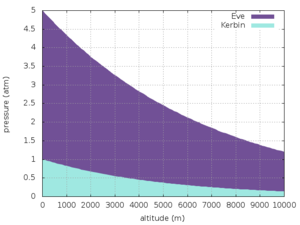Difference between revisions of "Eve"
(→Topography: about the liquid in the lakes) |
(→Topography: reworded to be more accessible) |
||
| Line 34: | Line 34: | ||
[[File:Eve_isa_mapsat.png|thumb|right|A topographic map of Eve made with the ISA MapSat plugin]] | [[File:Eve_isa_mapsat.png|thumb|right|A topographic map of Eve made with the ISA MapSat plugin]] | ||
--> | --> | ||
| − | Eve has several oceans and large, flat continents with a few mountain peaks. The composition of the liquid which fills the oceans and lakes is unknown | + | Eve has several oceans and large, flat continents with a few mountain peaks. The composition of the liquid which fills the oceans and lakes is unknown, but it is unlikely to be water because the boiling point of water is slightly below the surface temperature, even when taking the high atmospheric pressure into account. The land masses look like purple sand dunes. Its tallest point is 6450 m above sea level and is just south of the equator, at 1.90° W, 11.86° S. |
== Atmosphere == | == Atmosphere == | ||
Revision as of 01:16, 10 March 2013
Eve is the second planet from Kerbol and is the second largest body orbiting it. It is purple in appearance. It has one small moon, a captured asteroid called Gilly.
Eve is the closest planet to Kerbin and the easiest to reach, requiring the least delta-v of any planet. Having a similar size to Kerbin gives it a large gravity well. The result is that it requires the most delta-V of any celestial body with a solid surface to escape from it. Its thick atmosphere (much thicker than Kerbin) makes aerocaptures and landings easy, but makes a start from sea level even harder because most fuel will be wasted on overcoming atmospheric friction.
The combination of high gravity and thick atmosphere makes return missions from the sea level of Eve very difficult.
Contents
Topography
Eve has several oceans and large, flat continents with a few mountain peaks. The composition of the liquid which fills the oceans and lakes is unknown, but it is unlikely to be water because the boiling point of water is slightly below the surface temperature, even when taking the high atmospheric pressure into account. The land masses look like purple sand dunes. Its tallest point is 6450 m above sea level and is just south of the equator, at 1.90° W, 11.86° S.
Atmosphere
Eve's atmosphere begins at 96,708.6 m and is extremely dense: at 11,250 m, it's as thick as Kerbin's atmosphere at sea level (1 atm), and at Eve sea level the atmospheric pressure is 5 atm. Its atmospheric pressure fades exponentially, with a scale height of 7000 m.
In general, the atmospheric pressure on Eve at an altitude expressed in meters is:[1]
From within Eve's atmosphere, the sky appears indigo during nighttime. During dawn and dusk, the sky is green. The atmosphere is possibly composed of iodine, given its purple coloration.
Jet engines do not function in Eve's atmosphere, since it contains no oxygen — they make noise and consume fuel, but they produce no thrust. Planes with other propulsion methods do however work very well in Eves atmosphere and are a great way to explore the planet. Try to stay on a height between 35km and 25km where the atmosphere generates enough lift to glide and steer, but not so much drag that it slows you down too much.
As with version 0.17.1 of aerobraking maneuver arriving from Kerbin and resulting in to orbit around Eve - without using fuel for braking - can be done aiming for at periapsis at aproximately 72500m.
The following table gives terminal velocities at different Eve altitudes. These are also the velocities at which a ship should travel for a fuel-optimal ascent from Eve, given the game's model of atmospheric drag.[2]
| Altitude (m) | Velocity (m/s) |
|---|---|
| 0 | 58.4 |
| 1000 | 62.5 |
| 5000 | 82.0 |
| 10000 | 115 |
| 15000 | 162 |
| 20000 | 228 |
| 30000 | 450 |
| 40000 | 888 |
| 50000 | 1.76×103 |
| 60000 | 3.47×103 |
Natural Satellites
Eve's only natural satellite is the tiny captured asteroid Gilly in a highly eccentric and inclined orbit. Gilly is currently the smallest celestial body in the Kerbol system.
Orbital Statistics
A geosynchronous orbit of Eve requires an altitude of 10373.195 km and a velocity of 858.95 m/s. For a semisynchronous orbit of ½ Eve day (11.25 hours or 40500 seconds) an orbit of 6275.676 km above Eve is needed with a velocity of 1082.2 m/s.
Reference Frames
Gallery
- Screenshot91.png
A Kerbal dropped in from space will survive impact with Eve, even when reaching speeds over the speed of sound.
Changes
- Art pass.
- Terrain tweaks — the tallest points are now about 6 km in altitude, compared to 11 km before.
- Initial Release
Notes
- ↑ A nuclear engine has a specific impulse of 220 in 1 atm or higher, 800 in vacuum, and the following at various Eve altitudes:
altitude (m) 11263 11268 11322 11598 11896 12200 12799 13868 14586 15292 16725 18711 22800 23556 32000 38000 43000 51963 specific impulse 220 220.2 224.6 246.9 269.9 292.4 334.0 400.0 438.8 473.4 533.7 600.2 688.2 699.8 769.8 787.3 793.8 798.3 - ↑ http://forum.kerbalspaceprogram.com/showthread.php/6664-Mini-challenge-max-altitude-with-this-supplied-spacecraft?p=100912&viewfull=1#post100912







